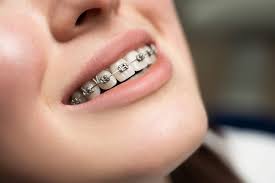+918048038015

This is your website preview.
Currently it only shows your basic business info. Start adding relevant business details such as description, images and products or services to gain your customers attention by using Boost 360 android app / iOS App / web portal.
BEST DOCTOR FOR BRACES TREATMENT IN KHARGHAR B...

BEST DOCTOR FOR BRACES TREATMENT IN KHARGHAR Braces are orthodontic devices used to correct dental and bite issues, such as misaligned teeth, crowded teeth, overbites, underbites, and more. They work by applying continuous pressure to the teeth over a period of time to move them into their correct positions. Here are some important points to know about braces: 1. Types of Braces: Traditional Metal Braces: These are the most common type of braces. They consist of metal brackets bonded to the teeth and connected by wires. Modern metal braces are smaller, less conspicuous, and more comfortable than older versions. Ceramic Braces: These braces are similar to traditional metal braces but use tooth-colored or clear brackets, making them less noticeable. Ceramic braces are often preferred for their cosmetic appeal. Lingual Braces: Lingual braces are placed on the back (lingual) side of the teeth, making them virtually invisible from the front. They are custom-made to fit each patient's teeth. Clear Aligners: While not technically braces, clear aligners like Invisalign are a popular alternative. They consist of a series of removable, clear plastic trays that gradually move the teeth. They are discreet, comfortable, and can be removed for eating and oral hygiene. 2. Orthodontic Issues Treated: Braces are used to correct a wide range of dental and bite issues, including: Crooked or misaligned teeth Overcrowded teeth Spaces or gaps between teeth Overbites (upper front teeth protrude) Underbites (lower front teeth protrude) Crossbites (upper and lower teeth don't align properly) Open bites (upper and lower teeth don't meet when the mouth is closed) 3. Treatment Duration: The duration of orthodontic treatment with braces varies depending on the complexity of the case and the type of braces used. On average, treatment can last anywhere from 12 months to 24 months or more. 4. Maintenance and Care: Proper care and maintenance are crucial during orthodontic treatment with braces: Regular dental check-ups are essential to monitor progress and ensure that your braces are functioning correctly. Good oral hygiene is important to prevent tooth decay and gum issues. Brushing and flossing can be a bit more challenging with braces, so your orthodontist will provide guidance on the best techniques and tools to use. Dietary restrictions may be recommended to avoid damaging braces. Foods that are sticky, hard, or excessively sugary should be avoided. 5. Aftercare: After your braces are removed, you will likely need to wear a retainer to maintain the results and prevent teeth from shifting back to their original positions. Retainers can be removable or fixed behind the teeth. 6. Consultation: If you or your child requires orthodontic treatment with braces, it's important to schedule a consultation with an orthodontist. They will assess your specific needs, discuss treatment options, and create a personalized treatment plan to address your dental issues and achieve a straighter, healthier smile. Remember that braces can significantly improve both the function and appearance of your teeth and bite. The decision to get braces is an investment in your oral health and overall well-being.

 +918048038015
+918048038015